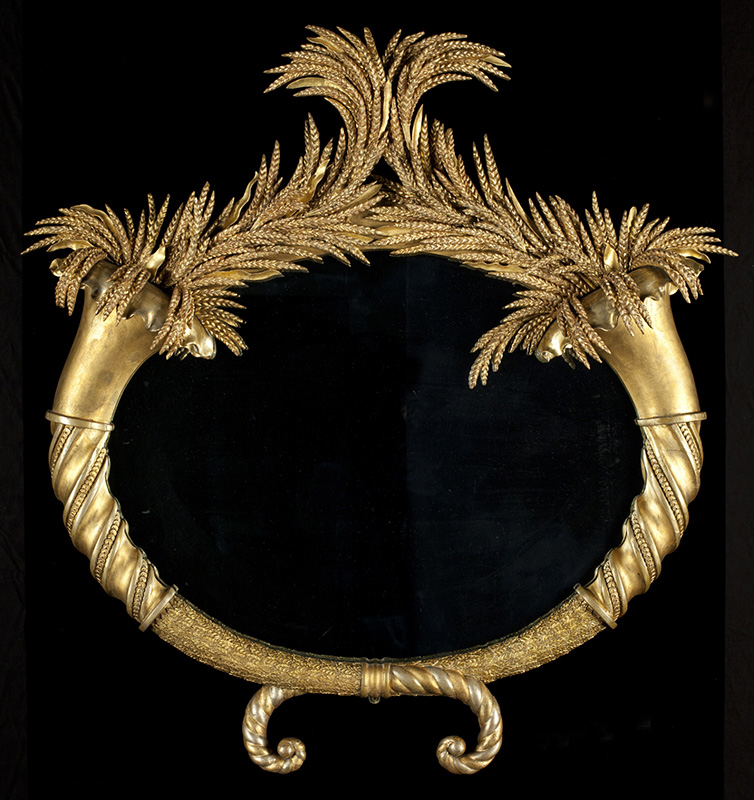An “American” Mirror at the Clark Art Institute
by Kathleen M. Morris
In 1997, Florence Cluett Chambers donated a looking glass with a spectacular double-cornucopia gilt frame to the Clark Art Institute (the Clark). She had inherited the piece from her father, George Alfred Cluett (1873–1955), a noted collector of American antiques.1
The looking glass arrived at the Clark as “Probably Salem, MA, c. 1820,” an attribution acquired during one of the periodic collection evaluations the family ordered starting in the 1970s. The earliest reference to the looking glass is in Luke Vincent Lockwood’s 1926 3rd edition of Colonial Furniture in America simply labeled a “gilded mirror, 1790–1800.” Cluett’s holdings of early American furniture was featured in the November 1954 issue of Antiques, where the cornucopia looking glass is described as “an unusual gilt Empire mirror, possibly made in New York.”
The frame is complex, with large sheaves of modeled and gilt wheat springing from the two horns and alternating bands of warm yellow and cool silvery gilding on the lower sections. During planning for a reinstallation of the American decorative arts collection, I targeted the mirror as a priority for conservation, as it was marred by areas of broken, discolored, and overpainted decoration.
Under the supervision of Williamstown Art Conservation Center furniture conservator Hugh Glover, Haejeong Yoon undertook the restoration project as a work-study internship awarded each year to a second-year student in the Williams-Clark Graduate Program in the History of Art. Yoon also worked with me and my colleague Alexis Goodin, Curatorial Research Associate, to research the object.
The cleaning and repair had splendid results, restoring much of the object’s luster. The project also resulted in a completely new understanding of the object. When the backing board was removed from the mirror, Glover and Yoon determined that this board was original but had been reversed at some point. What had been the visible back was thereafter obscured from view. On that hidden surface—most likely turned over in the 19th century prior to the mirror’s acquisition by Cluett—was an original manufacturer’s label. Though surviving only in partial form, an online search revealed a match on a mirror of similar form and decoration sold at Christie’s London in 1998. The label identified the maker of the looking glass as Georg Steinhäuser (b. 1779), a woodcarver, sculptor, and frame and mirror manufacturer who operated in Bremen, Germany. Many mirrors and frames were imported into the United States during this period, including a considerable number from Bremen, so it is possible that the object was made for the American market.2 When the backing board was turned over—whether by chance or by design—the German object’s origin was lost, replaced by an identification as “American,” whether from New York, Salem, or elsewhere.
The mirror hangs in the Clark’s Henry Morris and Elizabeth A. Burrows Gallery of American Decorative Arts, a reflection of the complex histories of the objects that furnished early American homes.
1 Mrs. Chambers, and later her estate, also donated other works from her father’s collection to the Clark. Cluett left American furniture to his other children as well, and a significant portion of his collection is now at Historic Deerfield.
2 Charles F. Montgomery. American Furniture, The Federal Period. (New York: The Viking Press, 1966), pp. 253–256.
Kathleen M. Morris is the Sylvia and Leonard Marx Director of Collections and Exhibitions and Curator of Decorative Arts at the Clark Art Institute in Williamstown, MA.
A print version of this article was published in The Magazine of the Decorative Arts Trust, one of our most popular member benefits. Join today!


